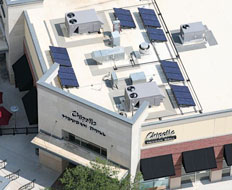Though the green movement is well underway in the quick-service industry, some operators are finding that one green tool, solar power, is no easy matter. More chains and independents are moving on the idea of using solar power to provide electricity and heat for their operations. But the technology has its limitations and poses operational challenges to operators.
“This is much more difficult and time-consuming than we originally thought,” says Chris Arnold, head of public relations for Chipotle, which is making a solar commitment in several of its stores. “There’s a lot of work to do to identify and prepare each project, and in a number of places it can go wrong.”
Still, Chipotle is sticking with its original plan to outfit about 75 restaurants with solar panels that will produce about 500 kilowatts of electricity and make the chain the largest direct producer of solar energy in the restaurant industry.
“Obviously, Chipotle has made a substantial commitment to getting renewable energy production in their stores, and that’s to be commended,” says Danny de la Torre, a manager for Standard Renewable Energy, the Houston-based company that is installing solar roof systems for Chipotle.
“Long-term, they’ll save money,” he says. “The [energy-cost] offset is pretty substantial with a project of this size, at this many locations.”
Attracting green-conscious consumers by riding on the coattails of the green movement remains one of the primary motivations for solar-power initiatives. Operators of The Plant: Café Organic, for instance, were happy to invest in alternative energy and to let patrons know of their devotion.
“We mention it on our menu, and customers react positively,” says Matthew Guelke, co-owner of the 120-seat fast casual in San Francisco. He says it’s too early to tell when the independent operation will recoup the $62,000 net cost of installing an array of 6-kilowatt photovoltaic panels that supply about 25 percent of the overall power for the kitchen.
Turning to solar power was natural for Tender Greens, a Los Angeles–based startup with four locations open around Southern California and two more on the way. The fast-casual concept features locally grown produce, humanely raised meats, line-caught fish, and local wines and microbrews in what the chain calls an “eco-friendly” setting.
Of course, Tender Greens is more than happy to reap the cost savings from installation of passive solar panels to heat the water used at its outlet in San Diego. It cost the company about $2,000 more to install the solar unit than a comparable quick-heating conventional system, but the energy bill for its hot water is about 30 percent less as a result. Co-owner Matt Lyman says he expects payback of the extra investment within five years.
The decision to go solar can be a complicated one for quick-serve and fast-casual operators, and a number of factors will affect the decision.
Clear Skies, High Sun
Only operators in persistently sunny climates, like the West and South, can consider solar power, as regular and prolonged exposure to the sun is required.
Jason’s Deli, for example, put solar panels on the roofs of four outlets in Austin, Texas, and on one in its hometown of Beaumont, Texas, a few years ago. But Jason’s Deli has grown into a nationwide chain of about 220 outlets in 28 states as far north as Minnesota and Pennsylvania, with plans to open about 20 more restaurants over the next year—and solar energy isn’t installed or in the plans for any of them.
Friendly Facilities
The power requirements of a typical quick-serve outlet are stiffer than for a retail store or gasoline station. So relatively large arrays of solar panels are required. At the same time, available roof space over restaurants can be hard to find, because of the vents and other holes required to keep the operation running. Installation may rely on a property manager that allows the panel installation to stretch beyond the footprint of the quick-serve outlet.
Because of this, Chipotle has so far only installed solar arrays at about 20 of the 75 outlets it targeted when the initiative was announced last fall. “The fallout rate is higher than we might have thought in that we have to consider several sites for every one that actually gets done,” Arnold says.
And as devoted as Tender Greens is to sustainable energy and the green movement, three of the chain’s four open locations won’t accommodate solar arrays because of floors above the restaurant or reluctant landlords.
Impact On the Bottom Line
A system adequate to meet just 20–30 percent of the peak power needs of a traditional-sized quick serve might cost $15,000–$20,000 to install. But the federal government provides thousands of dollars in tax credits for installation of most solar arrays, and local utilities and municipalities will often sweeten that pot.
As a result, even when financing the costs of the system over just a few years, solar power can nearly match the cost of regular power provided by the electric grid, de la Torre says.
At the same time, however, quick serves can’t just disconnect from the grid entirely. Most of their power at peak times has to come from the local coal, nuclear, or hydroelectric plant. And while batteries can store the power that solar arrays generate and provide it for use when the sun is hiding, the cost of such battery systems is prohibitive.
Bragging Rights
For operators, a crucial part of the appeal of using solar power is letting people know they’re doing it.
Standard Renewable Energy gives clients the ability to monitor and display on a TV screen in the restaurant exactly how much power is being provided by the roof array at any given moment, as well as the corresponding reductions in their carbon footprint.
At Jason’s Deli outlets in Austin, “customers can see exactly how much solar power we’re pulling down on a sunny day,” says Daniel Helfman, director of public relations. “In a town like Austin, people love it.”












